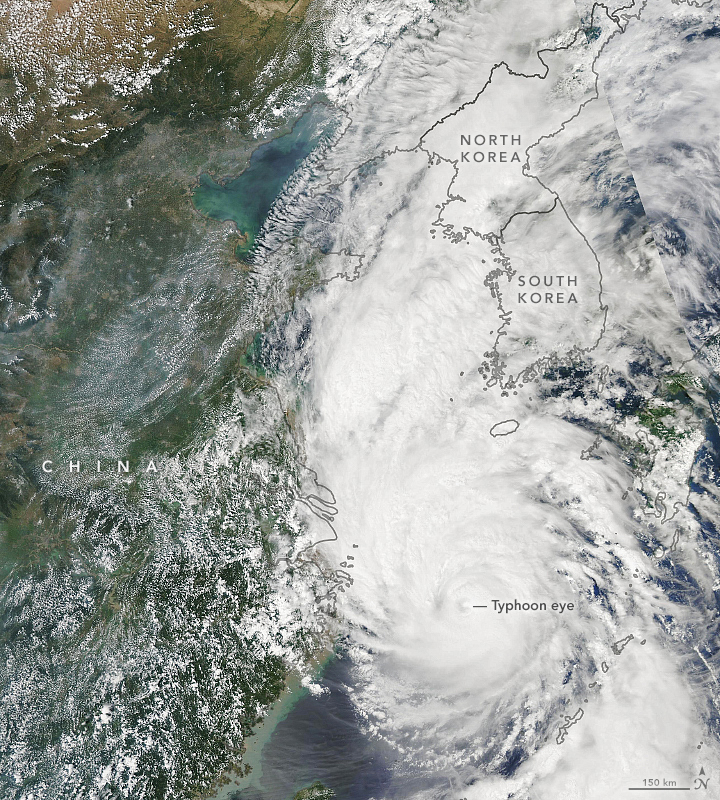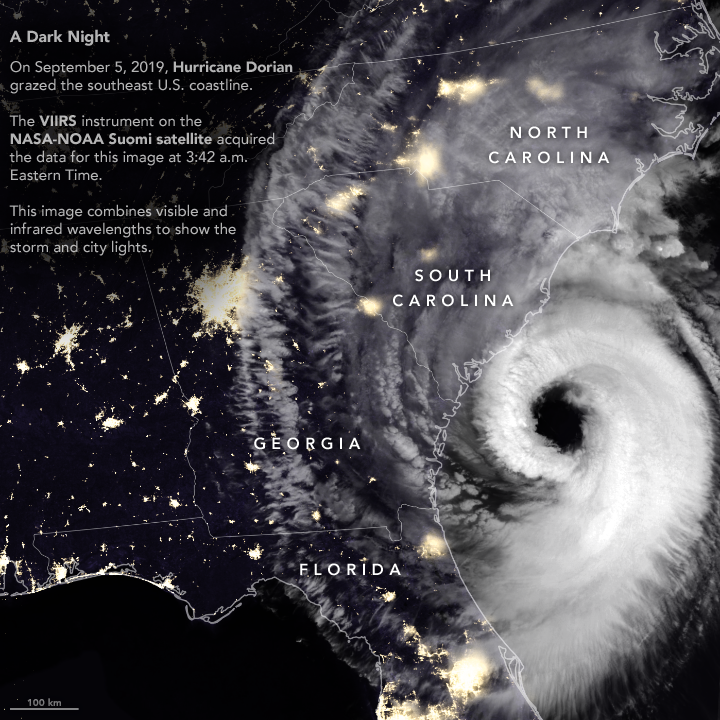Archive for the ‘Tropical cyclones’ Category
Typhoon Lingling
Saturday, September 7th, 2019“…….With maximum sustained winds of around 160 kilometers (95 miles) per hour, the typhoon is now headed toward South and North Korea.
The Moderate Resolution Imaging Spectroradiometer (MODIS) on NASA’s Aqua satellite acquired this image of the typhoon on September 6, 2019. The storm was moving north at 40 kilometers (25 miles) per hour and is expected to reach the Yellow Sea on September 7. It is then forecasted to make landfall in North Korea, according to the Japan Meteorological Agency.
The typhoon is expected to weaken as its outer bands interact with land on South Korea, but forecasters still expect torrential rainfall and damaging winds. Forecasters predict around 75 to 150 millimeters (3 to 6 inches) of rainfall and a storm surge, both of which may cause flooding and landslides.
Typhoon Lingling is the thirteenth tropical cyclone (typhoon or tropical storm) in the North Pacific this year. However, the Korean Peninsula typically sees just one landfalling storm per year…..”
NASA Earth Observatory image by Lauren Dauphin, using MODIS data from NASA EOSDIS/LANCE and GIBS/Worldview. Story by Kasha Patel.
NASA: Dorian skirts the eastern shoreline
Friday, September 6th, 2019After devastating the Bahamas and grazing Florida and Georgia, Hurricane Dorian rebounded and raked the coast of South Carolina with strong winds, heavy rains, and a storm surge. Wind, falling trees, and flooding damaged power infrastructure in coastal areas of the southeast U.S.
The Visible Infrared Imaging Radiometer Suite (VIIRS) on the Suomi NPP satellite captured this nighttime composite image as the storm approached the coast at 3:42 a.m. Eastern Time (07:42 UTC) on September 5, 2019. At the time, Dorian packed maximum sustained winds of 115 miles (185 kilometers) per hour and was moving north at 8 miles per hour.
The VIIRS sensor observed thick cloud bands circulating around Dorian’s large eye, the part of the storm with mostly calm weather and the lowest atmospheric pressure. Hurricane eyes average about 20 miles (32 kilometers); the National Hurricane Center reported Dorian’s eye had a diameter of 50 miles (80 kilometers) around the time this image was acquired. Thinner clouds—part of the storm’s higher-level outflow—extended well inland across Georgia, South Carolina, and North Carolina.
The VIIRS image was captured by the sensor’s day-night band, which detects light in a range of wavelengths from green to near-infrared and uses filtering techniques to observe signals such as gas flares, city lights, and reflected moonlight. Infrared observations from VIIRS were used to enhance the visibility of clouds. Optical MODIS satellite data was layered into the image to make it easier to distinguish between ocean and land surfaces.

It is not possible to identify the locations of power outages based on the VIIRS night light image alone. However, as of 2 p.m. on September 5, several utility companies and Poweroutages.us were reporting more than 240,000 outages in South Carolina. The hardest hit area was Charleston County, where companies were reporting more than 130,000 outages.
In the coming days, forecasters expect Dorian to move near or over the coast of North Carolina and then toward New England and Nova Scotia.
NASA Earth Observatory images by Joshua Stevens, using VIIRS data from the Suomi National Polar-orbiting Partnership, and power outage data courtesy of PowerOutage.us. Story by Adam Voiland.
FEMA SitRep 9/5/19
Thursday, September 5th, 2019Situation
Hurricane Dorian continues to move along the Southeast US coast and is expected to approach South Carolina today. Life-threatening storm surge and dangerous winds expected along portions of the coasts of GA, SC, and NC and portions of southeast VA and the southern Chesapeake Bay, regardless of the exact track of Dorian’s center.
Hurricane Dorian (CAT 3) (Advisory #48A as of 5:00 a.m. EDT)
• 70 miles SSE of Charleston, SC
• Maximum sustained winds 115 mph; moving N at 8 mph
• Hurricane-force winds extend 60 miles and tropical storm-force winds extend 195 miles
Lifeline All lifelines remain GREEN
Safety and Security • Mandatory evacuations in effect in FL (1 county); SC (8 counties) and NC (6 counties)
Food, Water, Shelter • FEMA Commodities have arrived at ISBs (NBEOC) •
Region IV: 113 (-26) shelters with 6.6k (-2.7k) occupants (FL: 32/1816; GA: 13/2,038; SC: 33/2015; NC: 35/792) (ESF-6 as of 6:00 a.m. EDT) • 1 Mega shelter open in Durham, NC with 1.5k capacity (ESF-6 as of 4 Sept 11:00 a.m. EDT)
Energy • SC: 190K reported without power (Eagle- I as of 7:30 a.m.EDT); Fuel industry partners affirm fuel supplies and distribution remain stable (NBEOC)
Transportation • Airports: SC: Charleston International Airport, Florence Regional Airport, and regional/county airports closed; NC: Wilmington International Airport closed (FAA as of 6:00 a.m.) • Ports: Canaveral and West Palm Beach re-opened with restrictions; GA: Savanah and Brunswick closed; SC: Charleston closed; NC: Wilmington and Morehead City closed
Local Preparations/Response • FL, GA, SC, NC, and Seminole Tribe of Florida EOCs at Full Activation; VA EOC at Partial Activation • TN, MS EOCs at Monitoring • Governors declared a State of Emergency for all counties in FL, NC, VA, STOF and for the coastal counties of GA and SC
Federal Preparations/Response • NRCC at Level I, 24/7 with all LNOs and ESFs • Region III RWC at Enhanced Watch; RRCC Level II (day shift only) o LNO deployed to VA • Region IV RRCC at Level I, 24/7 o LNOs deployed to FL, STOF, GA, SC, and NC • IMAT Teams deployed: o National IMAT East: FL o Region III IMAT: VA EOC o Region IV IMAT-1: FL; IMAT-2: GA o Region VII IMAT: SC o Region VIII IMAT: NC • ISB Teams deployed to AL, GA, NC, and SC o Charlie Team at Fort A.P. Hill, VA
Hurricane Dorian Lashing the Southeast US Coast; Tropical Storm, Hurricane, and Storm Surge Warnings in Effect from East Coast of Florida to Southeast Virginia
Thursday, September 5th, 2019


Hurricane Dorian is expected to slowly move northwestward along the Florida east coast through Wednesday. Dorian will remain a dangerous hurricane, spreading impacts along and near the Florida east coast and the coasts of Georgia, South Carolina, and North Carolina through late week. This will be a long-duration event with heavy rain, storm surge, damaging winds, and isolated tornadoes.
Wednesday, September 4th, 2019SUMMARY OF 500 AM EDT…0900 UTC…INFORMATION
———————————————-
LOCATION…29.2N 79.5W
ABOUT 90 MI…145 KM E OF DAYTONA BEACH FLORIDA
MAXIMUM SUSTAINED WINDS…105 MPH…165 KM/H
PRESENT MOVEMENT…NNW OR 330 DEGREES AT 8 MPH…13 KM/H
MINIMUM CENTRAL PRESSURE…963 MB…28.44 INCHES
DISCUSSION AND OUTLOOK
———————-
At 500 AM EDT (0900 UTC), the center of Hurricane Dorian was located
near latitude 29.2 North, longitude 79.5 West. Dorian is moving
toward the north-northwest near 8 mph (13 km/h), and a northwest or
north-northwest motion is expected through this morning. A turn
toward the north is forecast by this evening, followed by a turn
toward the north-northeast on Thursday morning. On this track, the
core of Hurricane Dorian will move dangerously close to the Florida
east coast and the Georgia coast through tonight. The center of
Dorian is forecast to move near or over the coast of South Carolina
and North Carolina Thursday through Friday morning.
Maximum sustained winds are near 105 mph (165 km/h) with higher
gusts. Some weakening is expected during the next couple of days,
and Dorian is expected to remain a powerful hurricane during the
next few days.
Hurricane-force winds extend outward up to 60 miles (95 km) from the
center, and tropical-storm-force winds extend outward up to 175
miles (280 km).
The minimum central pressure reported by an Air Force Reserve Unit
Hurricane Hunter aircraft is 963 mb (28.44 inches).





